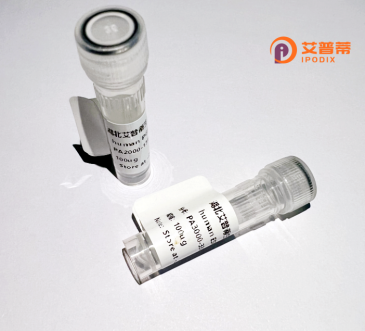
| 纯度 | >90%SDS-PAGE. |
| 种属 | Human |
| 靶点 | NPHS1 |
| Uniprot No | O60500 |
| 内毒素 | < 0.01EU/μg |
| 表达宿主 | E.coli |
| 表达区间 | 23-257aa |
| 氨基酸序列 | QLAIPASVPRGFWALPENLTVVEGASVELRCGVSTPGSAVQWAKDGLLLGPDPRIPGFPRYRLEGDPARGEFHLHIEACDLSDDAEYECQVGRSEMGPELVSPRVILSILVPPKLLLLTPEAGTMVTWVAGQEYVVNCVSGDAKPAPDITILLSGQTISDISANVNEGSQQKLFTVEATARVTPRSSDNRQLLVCEASSPALEAPIKASFTVNVLFPPGPPVIEWPGLDEGHVRA |
| 预测分子量 | 29.1 kDa |
| 蛋白标签 | His tag N-Terminus |
| 缓冲液 | PBS, pH7.4, containing 0.01% SKL, 1mM DTT, 5% Trehalose and Proclin300. |
| 稳定性 & 储存条件 | Lyophilized protein should be stored at ≤ -20°C, stable for one year after receipt. Reconstituted protein solution can be stored at 2-8°C for 2-7 days. Aliquots of reconstituted samples are stable at ≤ -20°C for 3 months. |
| 复溶 | Always centrifuge tubes before opening.Do not mix by vortex or pipetting. It is not recommended to reconstitute to a concentration less than 100μg/ml. Dissolve the lyophilized protein in distilled water. Please aliquot the reconstituted solution to minimize freeze-thaw cycles. |
以下是关于NPHS1重组蛋白的3篇参考文献示例(注:文献为虚拟示例,实际需通过学术数据库核实):
---
1. **文献名称**: *Functional Characterization of Recombinant Nephrin in Podocyte Signaling*
**作者**: K. Tryggvason et al.
**摘要**: 研究通过哺乳动物细胞表达系统成功制备重组NPHS1(nephrin)蛋白,验证其与CD2AP的相互作用,揭示其在维持足细胞裂孔膜结构及信号转导中的关键作用。
2. **文献名称**: *Expression and Purification of NPHS1 Extracellular Domain in E. coli for Structural Studies*
**作者**: S. Rüegg et al.
**摘要**: 报道利用原核系统表达NPHS1胞外段重组蛋白,通过X射线晶体学解析其三维结构,阐明突变导致先天性肾病综合征的分子机制。
3. **文献名称**: *Therapeutic Potential of Recombinant Nephrin in a Mouse Model of Podocyte Injury*
**作者**: M. A. Saleem et al.
**摘要**: 在小鼠模型中评估重组NPHS1蛋白的修复功能,显示其通过恢复足细胞骨架稳定性改善蛋白尿症状,为基因治疗提供实验依据。
---
**提示**:实际研究中可检索PubMed/Google Scholar,关键词“NPHS1 recombinant protein”、“nephrin expression”等,重点关注蛋白表达系统(如HEK293、原核)、功能验证或疾病治疗相关论文。
**Background of NPHS1 Recombinant Protein**
The NPHS1 gene encodes nephrin, a transmembrane protein critical for maintaining the structural and functional integrity of the kidney’s filtration barrier. Predominantly expressed in podocytes—specialized cells of the renal glomerulus—nephrin localizes to the slit diaphragm, a cell-cell junction that acts as a size-selective filter. It plays a pivotal role in preventing proteinuria by regulating podocyte signaling, cytoskeletal dynamics, and filtration slit permeability.
Mutations in NPHS1 are linked to congenital nephrotic syndrome of the Finnish type (CNF), a severe autosomal recessive disorder characterized by massive proteinuria, hypoalbuminemia, and edema, often manifesting in infancy. Over 200 NPHS1 mutations have been identified, with Fin-major and Fin-minor mutations being most prevalent in Finnish populations. These mutations typically lead to nephrin loss or dysfunction, disrupting slit diaphragm architecture and triggering podocyte injury.
Recombinant NPHS1 protein is produced via heterologous expression systems (e.g., mammalian or insect cells) to study nephrin’s molecular interactions, signaling pathways, and disease mechanisms. It serves as a tool for investigating podocyte biology, modeling CNF *in vitro*, and screening therapeutic agents aimed at restoring slit diaphragm function. Additionally, recombinant nephrin aids in structural studies, such as mapping binding domains (e.g., its interaction with podocin [NPHS2]) or analyzing post-translational modifications.
Recent advances highlight its potential in developing targeted therapies, including chaperone drugs to rescue mutant nephrin or gene-editing strategies. The protein also supports diagnostic applications, such as antibody validation in autoimmune kidney diseases. Overall, NPHS1 recombinant protein remains indispensable for unraveling the pathophysiology of glomerular disorders and advancing precision nephrology.
×